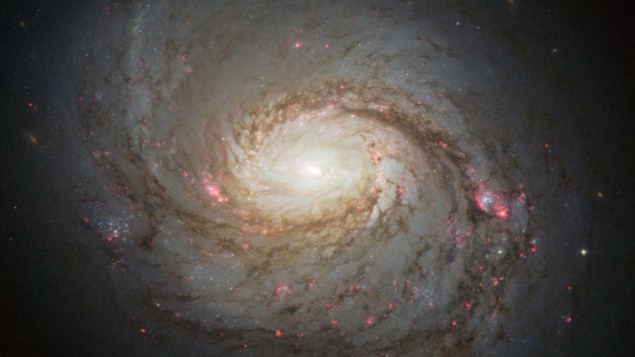
High-energy neutrinos from the active galactic nucleus (AGN) at the heart of the Messier 77 galaxy have been detected by the IceCube neutrino observatory. Also known as NGC 1068, the galaxy is harbours a supermassive black hole and the observations open a window into the violent processes that are believed to create cosmic rays.
Neutrinos are elusive particles that barely interact with other matter and can easily pass straight through the Earth. IceCube uses a cubic kilometre of ice beneath the South Pole to observe extremely rare collisions between cosmic neutrinos and water molecules. These interactions produce fast moving charged particles that create flashes of light in the ice called Cherenkov radiation. The light is captured by a network of more than 5000 detectors within the ice, allowing physicists working in the IceCube Collaboration to work-out where the neutrinos have come from.
IceCube announced its first observations of high-energy cosmic neutrinos in 2013 and five years later it made the first-ever detection of a cosmic high-energy neutrino from a type of AGN called a blazar.
Now, IceCube scientists are reporting their biggest haul of high-energy neutrinos ever. These are 79 particles from M77, which is a galaxy that is 47 million light–years away. The observations were recorded between May 2011 and May 2020 and the collaboration reckons that the neutrinos emerged from the core of M77’s AGN, which is otherwise hidden from our view by a thick torus of dust and gas.
Cosmic-ray connection
Astrophysicists believe that the 79 high-energy neutrinos were created when charged particles such as protons are accelerated to high energies by magnetic fields within the AGN. Some of these accelerated particles will escape the black hole and become cosmic rays. Others will collide with particles or photons within the AGN to produce a smattering of mesons. These mesons then decay quickly into gamma rays and neutrinos. In M77, the gamma rays are attenuated by the galaxy’s dusty torus, but most of the neutrinos pass through unhindered – with some eventually reaching Earth.
It is very likely that the particle acceleration involves the powerful, twisting magnetic fields that exist within an AGN. However, it is not clear where this magnetic acceleration occurs. Possible locations include the accretion disc of matter that swirls into the supermassive black hole or the glowing corona, which is the very hot region immediately surrounding the black hole. Another possibility is that the acceleration occurs in the jets of matter that blast out of the AGN in directions perpendicular to the accretion disc.
Frances Halzen of the University of Wisconsin, Madison, who leads the IceCube Collaboration, tells Physics World that the observations reveal that the neutrinos come from a region of the AGN called the “cocoon”, this is a core region of the AGN in which matter is blown outwards by the jets and enshrouds the corona.
No gamma rays detected
“The [gamma-ray] photons that are inevitably produced along with the neutrinos lose energy in the dense core and emerge at lower energies,” he explains. “This is underscored by the fact that the NASA Fermi [gamma-ray] satellite does not detect the source in the energy range of the neutrinos detected.”
The conventional view is that most particles and radiation emitted by an AGN originate in the hot accretion disc, however doubts have been growing as to the veracity of this thermal model of emission. Andy Lawrence of the University of Edinburgh points out that some AGNs have variable brightness, and these fluctuations occur too quickly to be associated with changes in the accretion disc. Lawrence, who is not involved in the IceCube collaboration, adds “It may be that a more sophisticated disc theory plus accompanying non-thermal emission in the disc corona or jet might do the trick.”
Indeed, this latest observation by IceCube seems to back up the idea that particle acceleration occurs in the corona of the AGN rather than in the accretion disc.
Next generation
Although the mystery of how particles are accelerated in an AGN cannot be solved with these 79 neutrinos, and upgrade of the detector called IceCube Generation 2 should be completed by 2033.

IceCube identifies four galaxies as likely sources of cosmic rays
Halzen says that Generation 2 has been designed to study neutrino sources such as AGNs. “The detector will have more than eight times the volume of IceCube and, importantly, better angular resolution as well. The combination of the two will allow detections with a year of data rather than a decade as is the case now.”
Messier 77 is a well-studied galaxy by amateur and professional astronomers alike. Understanding how it produces high-energy neutrinos could therefore allow M77 to become a Rosetta Stone for understanding other active galaxies.
The research is described in Science.



